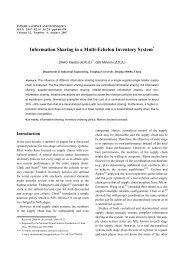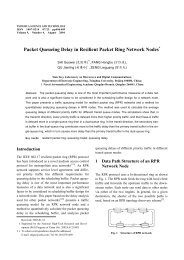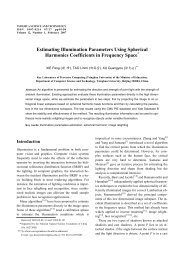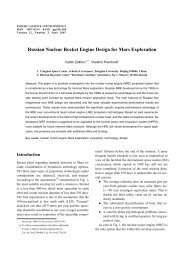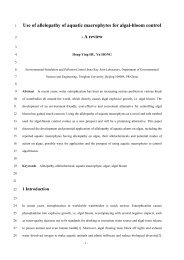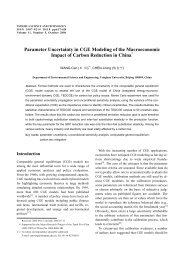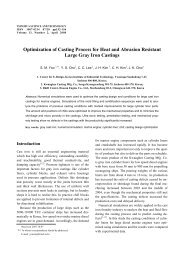Coordination by Option Contracts in a Retailer-Led Supply Chain with
Coordination by Option Contracts in a Retailer-Led Supply Chain with
Coordination by Option Contracts in a Retailer-Led Supply Chain with
Create successful ePaper yourself
Turn your PDF publications into a flip-book with our unique Google optimized e-Paper software.
WANG Xiaolong (王小龙) et al:<strong>Coord<strong>in</strong>ation</strong> <strong>by</strong> <strong>Option</strong> <strong>Contracts</strong> <strong>in</strong> a <strong>Retailer</strong>-<strong>Led</strong> …<br />
∞<br />
∫ eq ( 1+ q2 −d)d<br />
F( x| ε ).<br />
q1+ q2 Here, ΠS( ε , q1, q2)<br />
represents his second-stage problem.<br />
After mak<strong>in</strong>g the supplier’s second-stage problem<br />
<strong>in</strong>dependent of q 1 and after some algebra, the sup-<br />
plier’s problem is<br />
max Π ( q ) = ( c −c − o + o ) q + ( w − o ) d +<br />
q1d1 S 1 2 1 2 1 1 1 1 1<br />
∫<br />
0<br />
∞<br />
Π ( ε, q )d G(<br />
ε),<br />
S 1<br />
where ΠS( ε, q1) = max πS( ε,<br />
q)<br />
and<br />
qmax{ d, q1}<br />
π S( ε,<br />
q) = ( e− c2+ o2) q+ w2d2−ed−o2max{ d−q1,0} −<br />
q<br />
( e−v) ∫ F( x| ε )d x .<br />
d<br />
N N<br />
Let ( q , q 1 ) denote the solution to this problem, and<br />
then we have Proposition 1.<br />
Proposition 1 Given an option contract specified<br />
<strong>by</strong> the retailer, the supplier’s optimal total production<br />
quantity is<br />
N ⎧ N −1⎛e−<br />
c2 + o2<br />
⎞⎫<br />
q = max ⎨q1, F ⎜ ε ⎟⎬<br />
⎩ ⎝ e−v ⎠⎭<br />
.<br />
The proof is relatively straight forward s<strong>in</strong>ce the supplier’s<br />
problem follows a newsvendor structure.<br />
N<br />
Proposition 1 shows clearly that to coord<strong>in</strong>ate q =<br />
c<br />
e− c2 + o2 p− c2 + s<br />
q , it is necessary to set = , i.e.,<br />
e−v p− v+ s<br />
p− v+ s<br />
e= p+ s− o2<br />
(5)<br />
c2−v Based on Eq. (5), e v e+ o > c to make<br />
> and 2 2<br />
−1⎛ e− c2+ o2<br />
⎞<br />
F ⎜ | ε ⎟ mean<strong>in</strong>gful. Economically these two<br />
⎝ e−v ⎠<br />
conditions prevent the supplier from suffer<strong>in</strong>g losses.<br />
e+ o2is<br />
all the revenue that the supplier can get from<br />
one unit of product if it can be sold after the market<br />
demand is realized. If e+ o2 < c2,<br />
the supplier has no<br />
<strong>in</strong>centive to overproduce <strong>in</strong> the second period, and thus<br />
channel coord<strong>in</strong>ation is never reached. S<strong>in</strong>ce e= p+ s−<br />
p− v+ s<br />
o2<br />
, the two conditions are equivalent <strong>with</strong><br />
c2−v o2 < ( c2 − v)<br />
. Therefore, o2 < ( c2 − v)<br />
from now on.<br />
Next, consider the retailer’s problem. In all the fol-<br />
p− v+ s<br />
low<strong>in</strong>g parts, assume that e= p+ s− o2holds<br />
c2−v except where specified.<br />
The retailer’s problem is<br />
575<br />
∞<br />
max ΠR( d1) =−o1( q1−d1) − wd 1 1+∫ ΠR( ε, d1) d G(<br />
ε),<br />
d10<br />
0<br />
where ΠR( ε, d1) = max πR( ε,<br />
d)<br />
and<br />
dd1 π R( ε , d) = −w2d2 −o2( q2 −max{ d − q1,0})<br />
+<br />
pE m<strong>in</strong>{ D, q} + v( d −Em<strong>in</strong>{ D, d})<br />
−<br />
eE m<strong>in</strong>{max{ D −d,0}, q −d} −<br />
sED ( − Em<strong>in</strong>{ Dq , }).<br />
Rearrang<strong>in</strong>g,<br />
max Π ( d ) = ( o − o ) q + ( w − w + o ) d +<br />
where<br />
d10<br />
R 1 2 1 1 2 1 1 1<br />
∫<br />
∞<br />
Π<br />
0<br />
R( ε, d1)d G(<br />
ε),<br />
ΠR( ε, d1) = max πR( ε,<br />
d)<br />
and<br />
dd R 2<br />
1<br />
π ( ε, d) = ( e−w ) d −( e− v) F( x| ε)dx+<br />
o max{ d − q ,0} + ( p+ s−e−o ) q−<br />
2 1 2<br />
∫<br />
( p+ s−e) F( x| ε )dx−sED.<br />
0<br />
q<br />
N N<br />
Let ( 1 , d d ) denote the optimal solution to the retailer’s<br />
problem. Proposition 2 describes the retailer’s<br />
order<strong>in</strong>g behavior.<br />
e−w2 e− w2 + o2<br />
Proposition 2 Denote α = , β = ,<br />
e−v e−v N −1<br />
N<br />
and γ ( ε) = max{ d1, F (max{ α,0}| ε)}.<br />
Def<strong>in</strong>e ˆ( ε d1<br />
) =<br />
N<br />
N<br />
sup{ ε: Fd ( 1 | ε) max{ α,0}}<br />
and allow ˆ( ε d1<br />
) = +∞<br />
if ε max is <strong>in</strong>f<strong>in</strong>ite. For a given option contract, the<br />
optimal order<strong>in</strong>g behavior for the retailer has the follow<strong>in</strong>g<br />
structure:<br />
(1) After the market signal ε has appeared, the optimal<br />
total order quantity is determ<strong>in</strong>ed as follows:<br />
(i) If Fq ( 1 | ε ) β ,<br />
N<br />
d = γ ( ε ) ;<br />
(ii) Otherwise,<br />
−1<br />
⎧ γε ( ), if πR( ε, F (max{ α,0}| ε))<br />
><br />
⎪ N −1<br />
d = ⎨ πR( ε, F ( β | ε));<br />
⎪⎩ −1<br />
F ( β | ε),<br />
otherwise.<br />
(2) The optimal first-period order quantity is given<br />
<strong>by</strong><br />
N ˆ( ε d1<br />
)<br />
N<br />
2 1 1<br />
0<br />
2 1<br />
∫<br />
w − w + o + [ e−w −( e− v) F( d | ε)]d G(<br />
ε)<br />
= 0<br />
when e+ o1 > w1.<br />
Otherwise, N<br />
d1 ≡ 0 .<br />
Corollary For some second-period option price(s)<br />
−1<br />
o 2 such that β > 0 and set A= { ε : πR( ε, F (max{ α,<br />
−1<br />
0}| ε )) π ( ε, F ( β | ε))}<br />
is not empty, there exists a<br />
R<br />
∫<br />
0<br />
d



